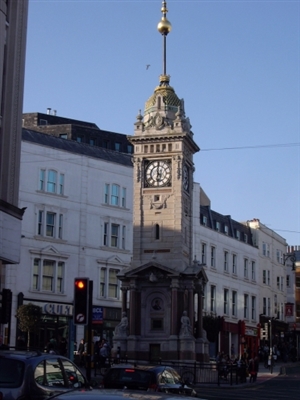The Volk’s Electric Railway is claimed to be the oldest electric railway in the world. It is certainly still transporting people (with a high percentage of children) along the seafront, between the promenade and the beach. I did notice that a suitable shingle bank screens the day-trippers on the train from the naturists beach!

Magnus Volk was born in Brighton in 1851 to German parents. it seems that at the age of 14 he had to take over his father’s clockmaking business. However, his interest soon turned to electricity and he first became well-known in 1879 when he installed the first telephone line in Brighton from his house to another nearby. I heard it said that Magnus gave telephone hand sets to all the local councillors so as to get support for his plan for a local exchange and that he went on to erected the original telephone equipment in Brighton, Hove and other Sussex towns. Just a year later he lit his own house by electricity, which led to his appointment as electrical engineer to the Corporation of Brighton. Then in 1883 he installed electric lighting in the Royal Pavilion, which was then the largest installation of its kind in the country.

During this time Magnus Volk had built a small electric motor. With this, a Siemens dynamo and a two horse power gas engine, he carried out some experiments that led to the electric railway. His first version, opened in 1883, had a two feet gauge and the current to the train was directly through the wheels from a 50 volt supply. Today the track is of 2 ft. 8 ½ in. gauge, apparently the only one of this measure in Great Britain and uses a third rail to supply current to the motors in the cars. A 90 h.p. motor generator converts the mains supply to a direct current of 160 volts. It seems that Volk also built another, short-lived line, similar to the VER, in the pleasure grounds at Aston Hall, Birmingham.

Apart from building his own electric car (and supplying one to the Sultan of Turkey), the most striking development by Magnus Volk was the ‘The Brighton and Rottingdean Seashore Electric Railway’ (a.k.a. the "Daddy Long-Legs”). This two-deck electric tram stood some 23 feet above the rails and could travel through 15 feet of water (when the tide came in). Unfortunately the ‘daddy long-legs’ is no longer with us, but if you want to find out more about it you can go to The Brighton Toy and Model Museum web site.
Magnus Volk died in 1937, but if you go to Brighton today you can see another legacy of his inventiveness. The golden "Time Ball" on the top of the Jubilee Clock Tower, built in 1888 for Queen Victoria's Jubilee, was designed by Magnus Volk to be hoisted up the pole and dropped on the hour as a visual timing signal. You can see that my photo was taken at six o’clock, just as the ball was about to fall. Unfortunately I missed photos of it falling due to oncoming traffic!